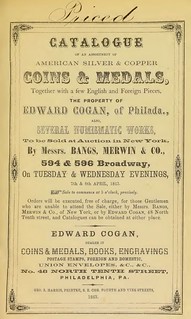
PREV ARTICLE
NEXT ARTICLE
FULL ISSUE
PREV FULL ISSUE
DIGITIZING THE ANS AMERICAN AUCTION CATALOGS
The cover article by librarian David Hill on the 2016 Issue 4 of ANS Magazine from the American Numismatic Society discusses the recent digitization of the society's American auction catalog collection in conjunction with the Newman Numismatic Portal. With permission, here's an excerpt, sans footnotes. That's dealer Henry Chapman below.
-Editor
When you're handling a few thousand auction catalogs, you begin to notice things. There are the interesting collectors, for example. I'd love to know more about John Guild, "The Man With Remarkable Memory" whose collection was sold by New York Coin and Stamp in 1904, but when it comes to Guild, it seems the world has lost its memory; I couldn't find anything else on him. Not so the "eminent comedian" John T. Raymond. He made quite a name for himself on the American stage as Colonel Mulberry Sellers in Mark Twain's Gilded Age. His lackluster collection included an altered 1803 silver dollar that he had been duped into buying for $300, believing it to be one of the precious 1804s. It sold for $5.60.
Given my experiences with the cataloging at the ANS Library, I was not at all surprised to find that the previous work done on the auction catalogs was excellent. There were only two I discovered so far that had not been cataloged at all and had to be added to DONUM. And I found very few errors. Coin catalogs were among the first items acquired for the ANS library, according to an accession list kept from 1858 to 1864. The first official catalog of the library, compiled by Richard Hoe Lawrence in 1883, lists about 140 foreign auction catalogs, though, curiously, for U.S. catalogs readers are referred instead to an annotated copy of Emmanuel Joseph Attinelli's Numisgraphics. By 1917, ANS secretary Bauman Belden could proclaim of the American catalogs, "We now have what is in all probability the most nearly complete set ... in existence." In recent decades, the ANS auction catalogs have been a foundation for several reference works on the topic. John Adams made use of the ANS Library ("the very bastion of comprehensiveness") for his United States Numismatic Literature, the first volume of which appeared in 1982, followed by a second one in 1990. More than just a bibliographic checklist, Adams work is readable and entertaining, with 36 biographical and historical sketches bringing to life a century-and-a-half's worth of numismatic characters, beginning with "our first coin dealer," Edward Cogan. Attinelli's book, published in 1876, arrived as coin collecting had been thriving in the United States for a couple of decades, going back to when elite collectors had gathered themselves into groups like the ANS in New York City (1858) and similar ones in Philadelphia and Boston. At this time, the majority of coins were bought and sold at auction. Clients would hire an expert—Ebenezer Locke Mason, for example—to catalog a collection, which was then sold through an independent auction house like Thomas Birch & Son of Philadelphia. Coins at first shared space with all kinds of bric-a-brac and scientific specimens, objects to fill the fashionable "cabinets of curiosity" of the day—Indian relics, bird skins, eggs, guns, shells. At first such catalogs were feverishly collected and shared among the early enthusiasts, but they gradually fell out of favor (despite innovations like the photographic coin illustrations that first made their appearance in United States auction catalogs in 1869). I find it immensely satisfying, especially as I look back on the history of the collection and think about those who saw long-term value where others saw only ephemera, to have a hand in making these catalogs instantaneously available throughout the world. Though inconceivable to the individuals who began assembling the collection over 150 years ago, I have no doubt they would have embraced this as a natural step in a project they initiated so long ago.
For more information on the American Numismatic Society, see:

Wayne Homren, Editor The Numismatic Bibliomania Society is a non-profit organization promoting numismatic literature. See our web site at coinbooks.org. To submit items for publication in The E-Sylum, write to the Editor at this address: whomren@gmail.com To subscribe go to: https://my.binhost.com/lists/listinfo/esylum All Rights Reserved. NBS Home Page Contact the NBS webmaster 
|

